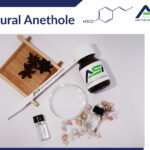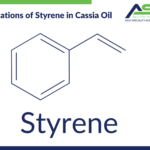An aromatic renowned for its characteristic cinnamon aroma, cinnamic aldehyde plays a significant role in various industries ranging from flavoring and fragrances to pharmaceuticals. In this article, we delve into ten fascinating facts about Cinnamic Aldehyde. Whether you’re a chemistry enthusiast, a health-conscious consumer, or simply curious about the science behind this aromatic, these insights will provide a comprehensive understanding of Cinnamic Aldehyde and its multifaceted nature.
Table of Content
ToggleWhat is Cinnamic Aldehyde?
Cinnamic Aldehyde (CAS No. 104-55-2) can be also known as Cinnamaldehyde, Phenyl Allyl Aldehyde, β-phenylacrolein, and 3-phenyl-2-propionene. It is an organic compound with the formula C9H8O or C6H5CH=CHCHO, naturally found in cinnamon oil, cassia oil, patchouli oil, laurel leaf, hyacinth, rose, Herba Lysimachiae and so on. There are Cis-isomer and Trans-isomer of Cinnamaldehyde, but in nature the trans (E) isomer is predominant.
It is a pale yellow to yellow liquid that can be extracted from the bark and other parts of cinnamon trees and other members of the genus Cinnamomum. The strong special odor and flavor of cinnamon that we’re familiar with come from this substance.
Read more about Cinnamic Aldehyde: https://asi-vn.com/cinnamaldehyde-against-cardiovascular-diseases/
10 facts about Cinnamic Aldehyde
-
It was first isolated and produced in the mid-1800s in Europe
The famous French chemists Jean Baptiste André Dumas (1800–1884) and Eugène Melchior Péligot (1811–1890) successfully isolated Cinnamic Aldehyde from cinnamon essential oil in 1834. 20 years later, in 1854, Luigi Chiozza, an Italian chemist, synthesized the substance in the laboratory. However, its chemical formula was only deciphered in 1866 by the German chemist Emil Erlenmeyer (1825–1909).
-
There are many ways to produce Cinnamaldehyde, but mostly from nature
The current commercial production involves steam distillation of cinnamon or cassia tree parts such as leaves, twigs, and bark. Steam contains soluble essential cinnamic oil, which will be collected as the steam cools. Factories then use fractional distillation to isolate Cinnamaldehyde.
Another method to produce cinnamon is to synthesize Acetaldehyde (CH3CHO) and Benzaldehyde (C6H5CHO). After the water is removed, the two reactants condense to produce Cinnamaldehyde.
-
It is a common ingredient used in flavor and fragrance
Cinnamaldehyde has a strong ability of fragrance holding. Its most common use is as a flavoring for chewing gum, ice cream, candies, e-cigarettes, and beverages. Additionally, it can be found in some natural, sweet, or fruity perfumes. The chemical may be partially utilized by aromas such as butterscotch, apricot, almond, and others for their pleasing scents. It is possible to utilize cinnamon as a food adulterant; for example, fruit essences, such as apple and cherry essences, can be made with Cinnamic Aldehyde and utilized in confectionery, ice cream, drinks, gum, cakes, and tobacco products.
-
It has antibacterial and antifungal properties
Numerous studies have been conducted on the biological properties of cinnamaldehyde, including its antibacterial properties. Cinnamaldehyde is primarily known to impede cell division and enzymes that synthesize cell walls in fungi. It also acts as a noncooperative inhibitor of β-(1,3)-glucan synthase and chitin synthase. At low concentrations, it inhibits several cytokinesis-related enzymes.
The effectiveness of antimicrobials in stopping and deactivating E. Coli biofilm on urinary catheters was also assessed. It was discovered that every concentration of Trans-cinnamaldehyde employed effectively stopped and eliminated the E. Coli biofilm that developed on pieces of urinary catheters.
Strong antibacterial actions are seen against Aspergillus flavus, Aspergillus niger, Paecilomyces citrinum, Fusarium moniliforme, Alternaria, Geotrichum candidum, and yeast at a dosage of 25 * 10-4.
-
Cinnamic Aldehyde can be good for diabetes
A 45-day treatment with 20 mg/kg of cinnamaldehyde decreased plasma glucose and glycosylated hemoglobin levels, serum total cholesterol, and triglyceride levels while increasing insulin, high-density lipoprotein (HDL) cholesterol, and liver glycogen levels in male rats with streptozotocin-induced diabetes, according to a 2007 study. Through the modulation of hyperlipidemia, oxidative stress, and inflammation, cinnamaldehyde mitigates atherosclerosis caused by a high-fat diet. An increasing body of research suggests that metabolites of cinnamon may enhance hyperglycemia and lipidemic indicators.
-
Our DNA can be repaired by Cinnamic Aldehyde
Dietary antimutagen cinnamaldehyde efficiently prevents both induced and spontaneous mutations. According to experimental data, cinnamon aldehyde causes a particular kind of DNA damage in human cells and the bacteria Escherichia coli. This damage prompts recombinational DNA repair, which in turn lessens spontaneous mutations. When mice were administered cinnamaldehyde orally following X-ray irradiation, the amount of X-ray-induced chromosome abnormalities decreased, possibly as a result of Cinnamic Aldehyde stimulating DNA repair.
-
Cinnamic Aldehyde is recognized as safe and approved for food use by FDA
Cinnamaldehyde is already classified in the GRAS (Generally Recognized As Safe) list by FDA. This list includes various substances, from commonly used flavorings and spices to phosphates and carrageenan. These substances are considered harmless under prescribed conditions of use.
-
It is an eco-friendly corrosion inhibitor for steel and other alloys
Most of the corrosion inhibitors used in heavy industries are found to be toxic and non-biodegradable in nature. Acetylenic alcohols, such as propargyl alcohol, although highly efficient in their performance, even at high temperatures, tend to be extremely toxic. Trans-cinnamaldehyde, on the contrary, is a much greener alternative and has been known to be one of the best corrosion inhibitors for steel and other alloys, having corrosion inhibition efficiencies exceeding 90%. It is believed to form a protective film on the metal surface.
-
We can produce other aromatics using Cinnamic Aldehyde
Cinnamic Aldehyde has a wide range of commercially viable derivatives. Naturally occurring 3-phenylpropanol, also known as Dihydrocinnamyl Alcohol, is created when Cinnamic Aldehyde is double hydrogenated. It is scented with lilac and hyacinth. Similar to Cinnamic Aldehyde, Cinnamyl Alcohol also occurs naturally and has a lilac scent. It can also be made from Cinnamic Aldehyde. The alkene component is selectively hydrogenated to yield dihydrocinnamaldehyde. Important commercial scents like Benzaldehyde are made from Cinnamic Aldehyde as well.
-
Toxicology
Although Cinnamic Aldehyde is commonly used because of its low toxicity, the toxicity profile of cinnamaldehyde show that it is a skin and eye irritant, has acute dermal toxicity, is a strong skin sensitizer and is a respiratory irritant at high concentrations. It may cause allergic contact stomatitis in sensitized individuals. However, allergy to the compound is believed to be uncommon.
Read more about Cinnamic Aldehyde: https://asi-vn.com/all-about-cinnamic-aldehyde/
Conclusion
In conclusion, Cinnamic Aldehyde is a multifaceted compound with a rich profile encompassing its origins, chemical structure, and diverse applications. Cinnamic Aldehyde has proven invaluable in various fields such as flavoring, fragrance, and medicine. These ten facts provide a comprehensive overview of cinnamic aldehyde, underscoring its significance and complexity. Understanding these aspects allows for better appreciation and informed usage of this remarkable compound.
Asia Specialty Ingredients (ASI), part of Asia Ingredients Group (AIG), specializes in the production and global export of essential oils and natural aromatics. Our range of products is meticulously processed using only the finest natural ingredients sourced from the typical lands of Vietnam, including Cassia, Basil, Star Anise, and more, ensuring good product quality. Contact us for more collaboration opportunity!








